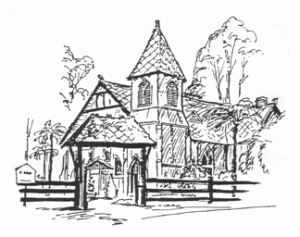St George’s Mt Wilson
St George’s Church was built in 1915 as a memorial to Henry Marcus Clark by his family. Henry Marcus Clark bought the property Balangra in 1910, after moving much of the original house to where Sefton Cottage now stands, he built a new home, naming it Sefton Hall.
 Land for the church was donated by Richard Owen Wynne, of Wynstay, one of the first properties to be established on Mt Wilson. Cliff O’Rourke and Albert Kirk, using a bullock team, cleared massive trees and thick undergrowth on the site. They were directed not to damage the tree ferns, with the result that many of them are standing in the churchyard today. Cliff’s horse team was used to transport the building materials from the railway at Bell. Fibro, the new wonder material imported from England and France, was chosen for its qualities of lightness and ease of construction. One of the builders working at Sefton Hall undertook to build the church, and as he was quite elderly, Albert Kirk helped by doing the high work such as nailing the roof timbers. As this was the time of the First World War, many Australian men were fighting overseas, including three older Kirk brothers, however Albert’s weak chest prevented him from enlisting. Timber battens were used to cover joins in the fibro walls, and the roof was also made of fibro, cut into tiles, painted and then carefully nailed in place. The structural timbers are Oregon from North America and the roof is lined with Baltic Pine from northern Europe. The windows, it is thought, were made in Sydney, while the pressed metal surrounds at the base of the building were popular at the time as a cheaper imitation of sandstone.
Land for the church was donated by Richard Owen Wynne, of Wynstay, one of the first properties to be established on Mt Wilson. Cliff O’Rourke and Albert Kirk, using a bullock team, cleared massive trees and thick undergrowth on the site. They were directed not to damage the tree ferns, with the result that many of them are standing in the churchyard today. Cliff’s horse team was used to transport the building materials from the railway at Bell. Fibro, the new wonder material imported from England and France, was chosen for its qualities of lightness and ease of construction. One of the builders working at Sefton Hall undertook to build the church, and as he was quite elderly, Albert Kirk helped by doing the high work such as nailing the roof timbers. As this was the time of the First World War, many Australian men were fighting overseas, including three older Kirk brothers, however Albert’s weak chest prevented him from enlisting. Timber battens were used to cover joins in the fibro walls, and the roof was also made of fibro, cut into tiles, painted and then carefully nailed in place. The structural timbers are Oregon from North America and the roof is lined with Baltic Pine from northern Europe. The windows, it is thought, were made in Sydney, while the pressed metal surrounds at the base of the building were popular at the time as a cheaper imitation of sandstone.
The organ originally stood halfway down the church on the right hand side. In the 1970s the present organ was donated by the Wentworth Falls Anglican Church and placed in its present position. This is an American organ and although quite old, is one of the best of its type. It was restored in 1994.
St George’s was consecrated in 1916, and was served for many years by the Rector of Mt Victoria and Hartley Parish. One or sometimes two services were held each month, with an occasional baptism or wedding. The Rector would quite often visit the folk living here, arriving with the mailman, or later in a hire car, and then walking around the village on foot. People still speak with great warmth of the Reverend Dorph, who in the 1930s and 40s provided understanding, humour, compassion and learning as he visited the people of this rather isolated community. In the 1960s the boundaries were altered so that Mt Victoria and Mt Wilson were included in the Parish of Blackheath.
In the grounds, members of the village have been buried over the years. Some of the graves date back to the 1920s with descendants of the original familles buried here. Sydney Kirk, grandson of Robert Kirk, his wife and eight of their nine children rest here. Edward Gregson, son of Jessie Gregson, his wife and some of his family are buried here. Plaques beneath the trees are for ashes of a number of past residents of the village.
Today the congregation is made up of a very small group from the Mt Wilson and Mt Irvine communities. These local people maintain and care for the church, the garden and grounds. It is open on the second Sunday of each month, and at other times on request.
St George’s is a church in the Anglican tradition, of its founders, the great reformers, Thomas Cranmer, Nicholas Ridley and Hugh Latimer. They were all martyred, during the brief resurgence of Catholicism under Queen Mary, for their stand on the authority of Scripture, its availability in the language of the common man, and for services freed from obscure traditions. The services at St George’s, firmly centred on biblical teaching, continue to aspire to their values.
WE MEET WEEKLY AT
08:45AM
St Peter’s Mt Victoria
10:30AM
St Aidan’s Blackheath
and monthly at
1st Sunday at 5pm
St John’s Hartley
2st Sunday at 3pm
St George’s Mt Wilson
All services are followed by a time of fellowship and refreshments
